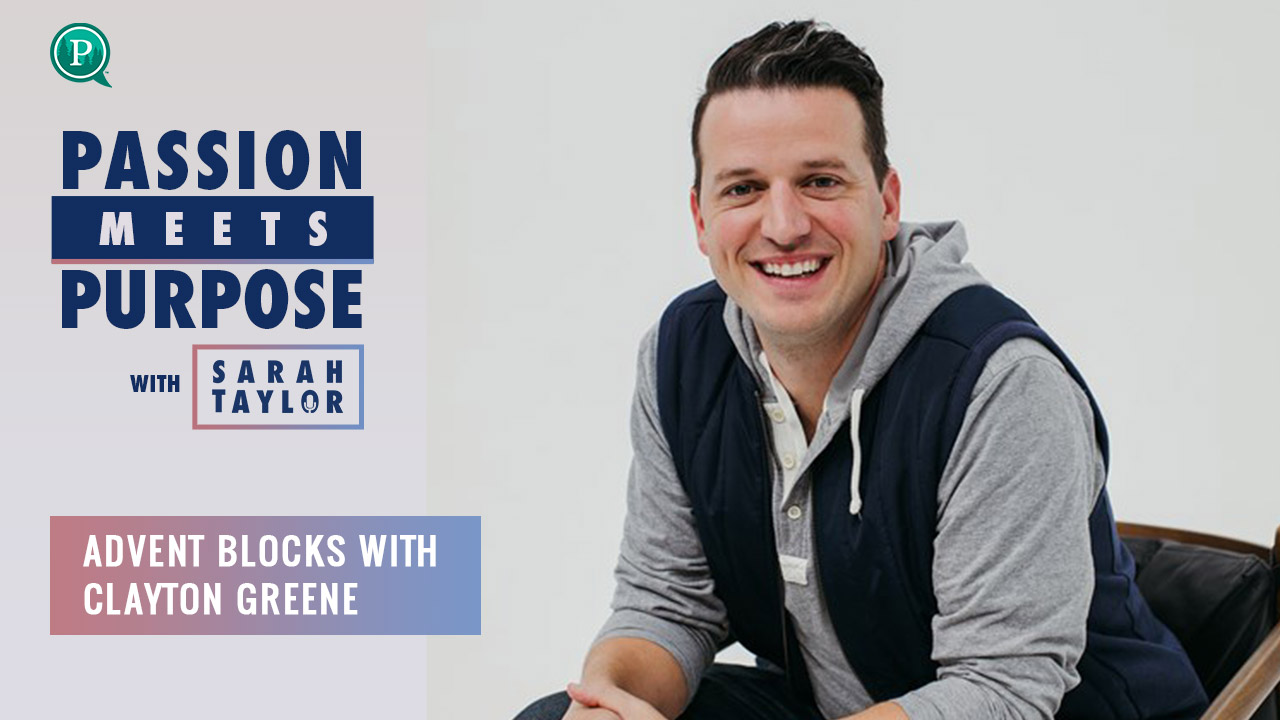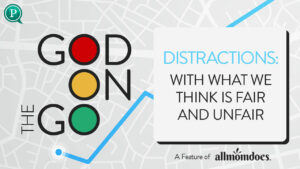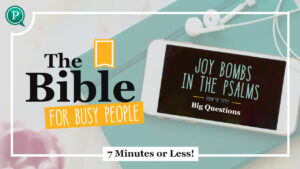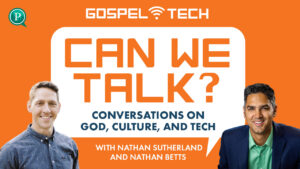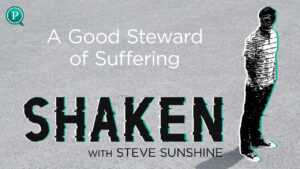“You say Christmas is all about Jesus, but it seems like its only about presents” was the catalyst for Clayton and his wife to create The Advent Blocks.
Special thanks to Seattle’s Union Gospel Mission for sponsoring the Passion Meets Purpose Podcast.
Interview Links:
Find Clayton: Online | Instagram
- BONUS! Use code PURPOSE for free expedited shipping on your purchase at goodkind.shop
Transcription:
Purposely. Your life. God’s purpose. Listen at onpurposely.com.
Sarah Taylor:
When I heard that you created this product, which I want you to tell the story of and to describe how beautiful they are and what they look like, it really came from your young daughter saying on December 22nd to you and your wife, “Christmas is supposed to be all about Jesus, but it seems like it’s only about presents.”
Clayton Greene:
She got us, didn’t she? Her name is Kara. Kara at the time was six years old, which it was like a knife in the back when she said that. I can picture ourselves in the living room when she said that and, over her shoulder, I can see all the presents. And I’m like, “You know what? Actually, I get it.”
Sarah Taylor:
Welcome to the Passion Meets Purpose podcast. My name is Sarah Taylor. This is where we discuss the things that you are naturally good at, your gifts, your talents, your abilities, and then how do you put those on display for the rest of the world. Let’s jump in with today’s guest.
His name is Clayton Greene and I found these Advent Blocks that he created about two nights ago. Thanks first of all, Clayton, for being my guest today, but thanks also for answering your Instagram DMs.
Clayton Greene:
Yeah, absolutely. You got to be on there pretty regularly. We try to take little breaks and stuff like that between email and social media. Take some time off on the weekend, but I’m so glad that you messaged us. Thanks for having me.
Sarah Taylor:
All right. The first thing we’re going to do is we’re going to explain what these Advent Blocks are, which is a little awkward because it’s not a visual medium. However, that’s what I was drawn to when I first saw them. Because as a mom of three kids ranging from high school down to elementary, I struggle when it comes to Christmas. I feel braced. I feel braced for the chaos.
These kids are sending me links as to all the stuff they want. I can’t keep track. And yet, when I heard that you created this product, which I want you to tell the story of and to describe how beautiful they are and what they look like, it really came from your young daughter saying on December 22nd to you and your wife, “Christmas is supposed to be all about Jesus, but it seems like it’s only about presents.”
Clayton Greene:
She got us, didn’t she? Her name is Kara. Kara at the time was six years old, which it was like a knife in the back when she said that. I can picture ourselves in the living room when she said that and, over her shoulder, I can see all the presents. And I’m like, “You know what? Actually, I get it.”
Sarah, the crazy thing about that story is that year we were actually doing a reading of some sort. We were doing something, but the reading that we were doing quickly before bed somehow wasn’t rivaling the anticipation of the lights and the songs and every new present that went under the tree.
Fast forward a year, November the next year, I’m like, “I’ve got to figure out something that can build anticipation towards the 25th about Jesus and not just about the presence.” Now, hear me clearly, we still do presents. With all the links you’re getting texted, I’m sure you’re going to do them as well. I actually think that all of the energy and momentum of the lights and the songs and everything can… Actually, we can capitalize on that if we then make sure, though, that Jesus is the center of the reason for the season for us. It rhymes and it’s a good thing to say.
I love working with wood. I drew some blocks, three different options of how it would move throughout the house in the center of the home. I showed them to my wife, Kristin. She pointed at the one in the middle and she said, “Do that one and call it Advent Blocks.” And I kid you not that it is, other than one small tweak, the exact same thing. We call it Advent Blocks.
The next day,, I texted my friend Chris who is an author, and I said, “Hey, if you’ll write a guide, I’ll make you some blocks.” And he said, “What kind of blocks are you talking about? But sure, I’ll write a guide.” And the rest is history. Five people that first year and then just we’ve continued to add more and more families every year after that.
Sarah Taylor:
These blocks are what you would imagine children’s ABC blocks or about that size. And then, you can put them on your mantle and you line them up 1 to 25, similar to an Advent calendar. And then each night, there’s a reading. I like that it’s short, it’s succinct, but yet it tells a different story as we are awaiting the arrival of Jesus. Talk more about your buddy, Chris, and how did he find those 25 stories?
Clayton Greene:
Yeah. That first year, we wanted to tell the story of the whole Bible, not just the story of the New Testament. Of course, you got to go all the way back, so we had one that was anchoring us at the very beginning. And then, we started just laying all the different stories and it ended up working out pretty beautifully that there are the family, the creation, and the family stories is one. You’ve got some kings and the judges are in there in the middle. We’ve got the prophets listed.
Every one of those movements has its few characters that you get to learn about. And then, what Chris does that is beautiful is a couple of things. He’s not here, so that’s when you can say the most flattering things about someone. One of the things that he does that’s so beautiful is he says that… He quotes someone else and I don’t remember that person, so I’ll quote Chris. “Any story that is simple enough for a child to understand can also be beautiful enough for an adult to understand.”
One of the beautiful things about how he writes is kids will love it and adults will cry. Just reading the family guide, he does a lot of callbacks throughout. There’s this refrain at the end of every story that talks about God coming to earth to stay. By day three, if you have a kid that’s seven years old, they will be saying that phrase with you every night. And if you have a kid that’s three years old… We say 3 to 13 is the sweet spot, but the high schoolers will listen if you’re reading to the youngers.
By day seven, even the three-year-old starts to say the refrain and that refrain piece is part of what builds that anticipation. Then, he does this unique thing, spoiler alert. Day 17, he changes the refrain just slightly. It becomes a little bit less like an anticipation: he’s going to come but that he is coming. That’s when we turn that corner to those great memorable New Testament stories that are leading right up to Jesus’s birth.
But the whole thing is all about God’s presence with his people, his presence and his sometimes perceived absence, but that his promise of being with his people is always true and we see that truly fulfilled in Christ. The blocks, one more thing about those, when you set them up, the stars on one end and there’s a globe on the other end… The star moves on top of the number every day, and so it’s like God coming to Earth.
There’s this visual approximation. Then on Christmas Eve, they all turn one more time to reveal a special surprise, Emmanuel, God with us, which is the theme of the entire book, the whole way along. There’s so many different pieces of it that were not… Well, I want to say they’re intentional, but they at least are so magical. There’s so helpful in drawing the attention towards Jesus during December.
Sarah Taylor:
What was your moment like when you realized that Emmanuel, God with us fit on that amount of blocks? Were you like… Did heaven sing?
Clayton Greene:
Yeah, it did. It did. The spacing and where you started them and everything… There were a couple of moves. There’s a comma, so we had to make sure that was in there and make sure that the comma wasn’t upside down. It was pretty great. I thought you were going to ask when was the moment that I realized that there was something special that had been created here just really as a solution for our family. But when we got to Christmas Day that year, and it’s been that same thing every year since… When we got to Christmas Eve and Christmas Day, our kids were as excited about reading that story as they were about to open the presents.
I would not lie about that if it wasn’t true. That won’t be every family’s experience, but it’s a lot of family’s experience. But there’s something about the writing and the blocks and the refrain that really just makes it… I mean, think about it like this. If you tell your kid… This is like a big theory of GoodKind at this point.
If you tell your kids, “I will do this fun thing with you if we ask,” your kids will want to do that thing with you and they will remind you. And then, if you say yes 25 days in a row, it actually is very hard not to have a meaningful moment. It’s actually very hard to not have that be something that is memorable and a sweet spot in everybody’s heart of all that time that you spend together.
And then if that yes is, “Yes, I will talk about and read you the story of creation and God and how he has come to be with us,” it’s almost inevitable that God uses that for something truly beautiful.
Sarah Taylor:
That’s one of the things you get feedback on, too. I heard you say that kids… One of the surprises was kids are driving this thing, kids are asking in the evening. Let’s not forget because you have that visual reminder. You see the seven turned around and then there’s the eight and the kids are like, “Don’t forget, we have to do this.”
Clayton Greene:
Absolutely. We say it’s amazing how kids can be such great accountability devices. But you explained, and by the way, thank you. You were very well versed in explaining how Advent Blocks work, so I appreciate you practicing that of how the blocks lay out and how the star moves and how the blocks turn and all those kinds of things. But that’s us trying to explain it because people are listening right now and not looking. You can go look at goodkind.shop, but that’s just because you can’t hear it. But here are the instructions: hand the set of blocks to your kids and that’s it.
That’s the only instruction, because then they take the book out and they’re like, “What’s this?” And you’re like, “I’ll read that to you,” and they take the blocks. And you know what they do when there’s blocks number one through 25? They put them in order. I mean, it just naturally happens by itself. That’s literally the instruction, which is why we love it so much because, like you were saying at the beginning, the pace of things, the pressure of a lot of other different things to do, it’s hard to muster up the strength and intentionality in December, even in a month where we really, really want to. And so having something that you can be delivered and it’s just open it up and it automatically is going to work is a gift that we love giving families each year.
Sarah Taylor:
Yeah. I mean, just on a personal note, I told you our youngest is seven and it’s interesting when it comes to the Christmas joy. You can always look to the youngest member in your family. If you’re not a parent, look for your niece or nephew. Find the youngest member of your family, and there is the purest Christmas joy. I grew up in a family that we read the, what is it, The Night Before Christmas? The clip-clop on the roof, that was like a family tradition.
It was years before I knew that the real story of Christmas came from Luke. It’s really important to me to develop these practices for my kids. Man, when they are young, the soil of their heart for the garden that God is going to grow is so rich. Whatever you plant in there, it just flourishes. I’m noticing with my seven-year-old, she comes alive when we talk about Jesus or the Star of Bethlehem. She is in on this and it is bringing the rest of our family around her wonder. So, she will line these up, she will ask for it every night. I’m so excited for her to bring my teenager out of her room and my sixth-grade boy and my husband. We’re not really a family story time kind of family, but yet this is bringing it into the house because the youngest is going to drive it. Thank you for what you’ve created.
Clayton Greene:
It’s been really fun. Also, Chris and I often say, “If no other family has ever used Advent Blocks, it would be worth it for our families,” because, I mean, genuinely we have experienced that type of thing. Our girls quote The King is Coming, which is the book all year long. They’ll use it in prayers. The benefit that has provided our family for this time of the year has been so meaningful for us as well.
Sarah Taylor:
And no shade on Elf on the Shelf. That’s fine, but that’s just not our family. I’m not about to do that. It’s fine. You can do that and you can do this, but I want to talk a little bit more… I love that you have reverse engineered why these work so well. We’ve talked about it a little bit, but I want to go one by one. So I’m going to read you one of the words and then you tell me about the secret sauce. The first thing is that it’s tangible. Talk to me about why holding the blocks and turning them and having it be tangible helps families stick with it more than just reading a little devotional.
Clayton Greene:
Oh, gosh. A couple of things. First of all, from a faith standpoint, we are embodied people. God gave us bodies, so there’s a physical nature to our experience. You can see that that was intentional and God has a continuation of that plan in Ebenezers and altars and communion. There is a tactical, practical nature, tangible nature to our faith that it’s built in because of our experience as humans.
But then secondarily, reminding yourself is a lot easier than remembering something. If I told you right now to tell Chris, “Happy birthday,” on March 20th… I don’t know if that’s actually my brother’s birthday. If I told you to tell my brother, “Happy birthday,” on March 20th this year, what’s the first thing that you would do?
Sarah Taylor:
Probably put it in my phone.
Clayton Greene:
You would write it down or you would put it in your phone. You would write it on a calendar. You put it on your phone. Why? Because remembering that is going to be much harder than reminding yourself when that time comes. This is why we think tangible items really, really matter is because our phones, our lives suck us into a whirlwind. We live in a 24/7 digital society. It’s just go, go, go, go, go, go, go, go, go. And sometimes we need something that says, “Stop.” Tangible items, we feel, say to us, “Stop,” in an analog kind of way.
Push notifications can often say stop, but in a different kind of way. We actually respect and use things that are push notifications and digital reminders, but we think that tangible reminders bring us to the present in a way that digital reminders can’t and in a way that we actually really, really need. That’s why that’s one of our words. Give me another one. That was fun.
Sarah Taylor:
Okay, good. Well, we’re going to do them all, spoiler alert. Secondly, for someone listening, maybe you’re going to find this podcast after Advent Blocks. Well, cool. Good news, they have Sabbath res-… They’re not kits. Are they kits? It’s a Sabbath box.
Clayton Greene:
Sabbath Family Kit. It’s a Sabbath box.
Sarah Taylor:
Okay, it’s a kit. And then, something around Easter, you have the GratiKube. I love these names. Really, your mission statement is about… Well, you say it better than I do, your mission statement.
Clayton Greene:
We want to help people celebrate the GoodKind of habits in holiday practices, have meaningful moments throughout the year to engage with God and each other.
Sarah Taylor:
Okay. All these words, I’m saying, apply for Advent Blocks, but they work for everything else. This is one of my favorites. It’s beautiful. That’s why I was drawn to it, right? These are not cheaply made. It’s beautiful and you even have almost a theological reason behind why that works as well.
Clayton Greene:
Oh, yeah, absolutely. I mean, if I’m honest… And you said this before we started recording, but there’s kind of a habit side of what we do and there’s kind of a Bible side of what we do. We like to say Atomic Habits, the book by James Clear, meets Eugene Peterson or John Mark Comer or Tim Keller or whoever you want. You pick your Bible person and it’s those two things put together.
Chris is the one that helps me really see the theological and the biblical side of this even more richly than I do myself. On the end of beautiful, we think about creation and the fact that God could had us have one bite of bland food a year and that could have sustained our bodies. He didn’t have to make food, but he did, and it was beautiful. God could have made one animal for the whole habitat and the whole world to function, but he made thousands of species and all these different things that are… There’s this beautiful mixture of our world functions, but it doesn’t just function. It’s beautiful. And.
The tangible piece, if we kind of gesture to that and say, “That’s function. Remind me,” there’s a beauty that is necessary in order to draw us in. I mean, that’s what brought… It caught my eye to it because there’s something special that’s going on there. God in creation both gives us the gift of beauty and function together. Sarah, I think this is so beautiful, then invites us into participating in that process of creating things that are beautiful and that function.
There’s that appreciation of those things. You don’t have to have one over the other, both at the same time, the full energy. That’s something I’m learning from a book I’m reading right now called Biblical Critical Theory, where it’s talking about these two things that could seem like they’re different but they’re not. They’re all together. So tangible and beautiful, they go together in a beautiful way.
Sarah Taylor:
Here’s one that people are going to love: easy. Easy is one of your pillars of the things that you create.
Clayton Greene:
Yeah. The instructions for Advent Blocks are, “Hand the box to your kids.” That’s it. It’s got to all be included in the box. I mean, this one is… We are big believers in small wins. We are big believers in compounding interest, not financially but spiritually. Small steps every day will go a much longer way than trying to take a huge step tomorrow. And then, in addition to the easy piece for a person, we want to say easy in terms of spiritual practice for everyone. We would much, much, much, much, much, much, much prefer an entire congregation memorize one verse from Romans than one person in the congregation memorize all of Romans.
If we’re going to get everyone engaged spiritually, we have to lower the bar, not to the extent of the bar always being low but to the extent of everyone being engaged. No one has any problem with the Couch to 5K. The Couch to 5K makes sense, because if you go try to run a 5K today and you haven’t run, you’re going to hurt something and you definitely won’t run tomorrow. But if you go walk half a mile today, you’ll probably walk half a mile tomorrow. So we’re much more into getting everyone engaged spiritually because we believe that if someone is engaged with God, the God who created the universe, the God who has promised to make a change in us as we engage in him, that he’s going to do that. Let’s lower the bar. Let’s get everybody engaged. Let’s make it as easy as possible.
Sarah Taylor:
Yeah, it’s like seed planting. That’s what comes to me. Seed planting is-
Clayton Greene:
Exactly. Yeah. Yeah.
Sarah Taylor:
Lastly, and you touched on this, but let’s talk about that reward. Let’s bring in a little psychology to this. That daily reward that builds is something that you design not just into Advent Blocks but your other practices as well.
Clayton Greene:
Yes. There’s a couple of examples here. Exercise, right? When you’re exercising, you’re doing it for a long-term benefit, but the short-term reward is what keeps you coming back over and over and over again. That is something that we agree that works in exercise, but we’re trying to say that also works in spiritual practice. The example in the Bible is manna.
Again, God does these things and we have to look at them and say, “Why did he do it that way every day?” You could only store it for one day when it was a Sabbath and he would give you a new manna every day. It was this tangible thing. Again, tangible coming in, but there was this reward. When you’re hungry, you need food. And so that hunger in them was being satiated by the food, but actually what it was doing was helping them rely on God.
For God to get his people to rely on him, what he did was provide something to them that actually satisfied something in them, but then they actually needed it again. Manna is the biblical example. The everyday example that we have is toothpaste. Do you know that toothpaste does not have to be minty or have suds in it? You’ve heard this, right?
Sarah Taylor:
I think I knew that. Yeah.
Clayton Greene:
Yeah. You could just rub toothpaste without the mint or without the suds on your teeth and it would provide the same benefit for you. The mint and the suds are there because it makes your mouth feel fresh. You enjoy that feeling and so you want to do it at night and the morning. Everybody should be brushing two times a day, right? The mint and the suds are there to help you keep coming back. What about floss? Floss does not have… They have a little bit of mint there, but it’s definitely not a satisfying experience.
Sarah Taylor:
It’s not as rewarding.
Clayton Greene:
It’s a horrible experience, right? It’s not as rewarding. It doesn’t make you want to come back and do it again. We’re saying your spiritual practices should look a little bit more like toothpaste than it looks like floss. Prayer and Bible reading doesn’t have to be hard for hard’s sake. We want to do something where we are enjoying it. There’s a lot of things you can do to help yourself enjoy the experience of prayer and Bible reading and silence and Sabbath and those types of things to keep you coming back. In the products that you mentioned, the turning the block, that’s the reward, because it’s the day and I felt like I did it. We would say that’s a good thing because it keeps you going over the longterm.
Sarah Taylor:
Let’s talk about some of your other ones here. You have something on here called Sticky Prayers. I mean, I think all of us would agree that we wish we… The Bible tells us, “Pray continually.” What does that look like, right? Yet, you have created Sticky Prayers. Talk about it.
Clayton Greene:
Sticky Prayers is a tangible that interrupts your day. We intentionally make them very thick and bumpy in order to catch your attention. And then, it has a short prayer on there. Again, lowering the bar to make it easy in order to interrupt you to get you started in the habit of engaging with God in conversation throughout the day, because we believe if you-
Sarah Taylor:
Talk about where you put these. Where do you put them?
Clayton Greene:
Yeah. Yeah. Yep. I have one on a water bottle. I can’t show you, but there’s one on my computer right here because I’d have to break my laptop in order to show you. There’s one on my car door and then there is one when I’m coming in through the garage. [inaudible 00:23:16]
Sarah Taylor:
Let’s talk about what they say.
Clayton Greene:
Yeah. In transition moments is where we’re putting them. The one on my computer here says, “God, where are you moving?” The one on my phone says, “God of heaven, allow me to rest in you.” The one in my car says, “I am here. I am listening.” It’s encouraging us to engage with God and remember things about God and repeat those back to Him.
Sarah Taylor:
Oh, that’s so good because I’ve heard of these. A friend of mine, Tim, he breathes out and he says, “Lord, you have my attention.”
Clayton Greene:
Yeah, that’s good.
Sarah Taylor:
Maybe it’s your next Sticky Prayer.
Clayton Greene:
Yeah. We’re going to put that on the Sticky Prayer. Yeah.
Sarah Taylor:
Thanks, Tim Timmons. Shout out, Tim Timmons. You can put a little trademark on there. Okay, another one. Let’s talk about… Man, Sabbath is hard in this day and age. Have you watched the… I think you mentioned John Mark Comer. He did a thing on Sabbath. Have you watched that?
Clayton Greene:
Yeah.
Sarah Taylor:
Okay, me, too.
Clayton Greene:
I haven’t watched but I’ve done some reading. Yeah.
Sarah Taylor:
I just finished it and the whole room at my radio station staff, we got uncomfortable when he talked about literally turning everything off and what that looks like for a full twenty-four hours. And yet, the Lord gave it to us for a reason. He knows that we need that. Talk about these Sabbath Family Kits.
Clayton Greene:
Yeah. The Family Kit part of it is there’s a five-week guide that comes in it that you can read. It comes with a deck of cards that helps you figure out what you’re going to pray and what you’re going to play, because we say that sabbath is… It’s stopping and enjoying God and all the good things that he’s done. We often get caught up on the stop part, which stopping is important, but sabbath is a practice of celebration, not a practice of suffering.
It’s turn everything off so that you can enjoy. The box is… I mean, I think John Mark Comer’s talked about a box. Ruth Haley Barton has talked about a Sabbath box. It’s a box that you put your stuff in. We did it with this. The top Flips back and forth to remind you of the difference of create and cultivate, what we’re supposed to do during the week, and it flips over and it says, “Stop and enjoy,” on the back. Again, that’s that tangible cue. It’s beautiful. It hangs on your wall, all of these things that we’ve reverse engineered from Advent Blocks in order to put that on the wall.
But I’ll be honest with you, it is the hardest of any of our items to get people to adopt because it is the hardest for Americans to do. Turning off the engine of toiling and creating our self-worth by our productivity is really, really hard. It’s, “Get ahead or lose.” It’s kind of like the mantra. It’s a hard practice, but you could also make the case, Sarah, that it was one of the most important practices we should be doing as well.
Sarah Taylor:
Let’s talk a little bit before we go just about, because so much of these episodes on here really is… I like to go back to childhood. You have this entrepreneurial spirit. You have this spirit that loves the Lord. You like to create. You said you like working with wood. Dial me all the way back to toddler Clayton. Where are some of the things that you thrive in today with the unique identity that God has given you? When did your parents see this in you from the get-go?
Clayton Greene:
Oh, gosh, that’s super interesting. My dad was an entrepreneur. He owned a wholesale florist. He was a photographer. He-
Sarah Taylor:
There’s the beauty part.
Clayton Greene:
Yep. Both of my uncles were heating and air technicians. They would install and service heating and air, so there’s the functional part. I don’t know. I always just felt like there was space in front of me in order to create and to do new things and take those types of risks. And so I really enjoyed those.
Also, the team that I’m working with now… It is not just me, but there’s a variety of different gifts. I mean, Chris’s writing is incredibly beautiful. We are always surprised whenever he passes something he has written to Brian, our designer, and he then makes images that reflect the same tone and temperament and content that Chris is writing.
And then, Lindsay is our photographer and videographer and she can tell a story with no words that Chris couldn’t tell with words. The team of all those… I’m just sometimes the person who comes in and says, “Hey, we should try to solve this problem. What do we want to do?” And then, together the team as a whole… I definitely have a great appreciation for the different ways that people are wired and strengths and weaknesses and how our team is functioning well together. I guess I’m just sometimes the one that is throwing out the crazy ideas. Maybe my parents just nurtured the crazy ideas that I was saying when I was a kid.
Sarah Taylor:
And then, there’s a church planting piece part of this as well.
Clayton Greene:
Yeah. I was initially trained as a physical therapist and then was asked to move and be the executive pastor of one of the church plants, a church plant that is in Wilmington, North Carolina, a church plant out of the church where I was at that time. And then, now I am actually able to support all of the church plants. There’s 65 church plants across the country that I support, help them thrive, and work towards multiplication. Even in that full-time job that I have, there’s this aspect of starting something new, solving problems, getting out there, and caring for people in how we’re serving them.
Sarah Taylor:
And a deep value for community, too. I mean, even as I was asking how you function, you brought in your team and the different gifts of each member of your team. And then, I also know that it’s your team’s desire that, as families do these Advent Blocks, not only would they do them as a family but in community as well.
Clayton Greene:
Yeah, absolutely. And with their local church. We stood up a local church program. We have a business accelerator that essentially… None of us went to business school, so we have somebody that teaches us how to run a business. We told them we wanted to do a local church program where we offer Advent Blocks to churches for 30% off. Essentially, they get wholesale pricing. They told us that we shouldn’t do that, because it was like… Well, because it messed with the margins a little bit more than they wanted to. And we’re like, “No, we’re selling it for this price because that’s what they can make,” because we believe… I mean, discipleship happens at home and in the church and it really should be doing both together.
The benefit of doing this alone is there, but the benefit of doing it with a group of people exponentially changes the impact of it, because everybody’s sharing and talking about the same stories. We’ve created a song that churches can use. We do sermon research and give it away to pastors so that they can teach in alignment with the stories in Advent Blocks. We do kids’ curriculum now. I mean, we just do everything we can as much as possible to let people do this and do it with their church.
Sarah Taylor:
Well, we would be remiss, you and I, if we talked all about it and didn’t offer a special discount to the person listening right now. Why don’t you talk a little bit about the person listening right now and what they can do to get their Advent Blocks, what we’re going to do for them?
Clayton Greene:
Yeah. The individual right now, you can go to goodkind.shop. That’s goodkind.shop. And when you are checking out, you can use the word Purpose. Now, I understand we’re airing this the end of November, which means time is of the essence. You should already be on the website now as we’re speaking. And if you use the code Purpose, you’re actually going to get express shipping for free if you order one set of Advent Blocks. Now, that’s very important because there’s a specific size that can come to you really quickly at that price that we can offer it for free. If you get two or three at the same time, the code won’t work because the cost of express shipping skyrockets. But one set of Advent Blocks blocks, express shipping for free, use the code Purpose and you can join us. It’s right around the corner.
Sarah Taylor:
Yeah. And then, I would love to invite you back when it comes closer to Easter for you to talk about-
Clayton Greene:
Yes, please.
Sarah Taylor:
… just the GoodKind of habits that our families can build around Easter as well. If you’re hearing this and let’s say it’s February and you’re like, “Bummer, I missed out,” click and subscribe. Also, listen, Clayton has a podcast as well. We’re going to link up to it in the show notes and it’s the GoodKind Podcast. Would you talk a little bit about what you discuss on there? You guys have tons of episodes. They’re great.
Clayton Greene:
Yeah. We have adopted a little bit more of a monthly cadence. Habits and holidays is where we live. We are anchored by what happens in a year, the two big Christian holidays. There’s other things that Christians are doing as well, but we’re also pretty enamored by just the holidays that everybody in our country is celebrating and what that does to us. What does July feel like and how should I relate to vacation? We do that once a month, where we talk about the month so we can prepare for the most meaningful moment.
And then, Chris and I are starting something in January where we’re going to be talking about spiritual practice and how to dive into each one of these spiritual practices to make them easy and tangible and beautiful and at the right time and in the right place. We’re going to dive into each one of them to try to get more people doing them and lower that bar, so to speak. You should definitely join us and we’d love to have you on as well.
Sarah Taylor:
I can’t wait for you to continue to see the ripple effect, because, I agree, discipleship happens in our homes, in our communities, in our local church, and I think that the ripple effect of what is happening in hearts of six and seven-year-olds and sixth graders and high schoolers and mothers who are… I recently had my first holiday meltdown. A couple of days before Thanksgiving, I’m just like, “This is too much. This is too much.” I’m so looking forward to the practice. This feels like a deep breath. It feels like everything I’ve been searching for. I just want to thank you for what you’ve done and that God would continue to bless it. I can’t wait for you and Chris and the rest of your team and your wives to see the ripple effect of what has happened from this that lasts the year round and for eternity.
Clayton Greene:
Yeah, thank you so much. I hope that as well.
Sarah Taylor:
Thanks so much for being here today on the Passion Meets Purpose podcast. We’re going to talk again in two weeks, but in the meantime, if you want to do us a huge favor, obviously, you know this by now. If you leave a review, it really helps others to find this podcast. It also helps us to make it better, and then you can contact us anytime at Purposely Podcasts. Until next time, thank you.

